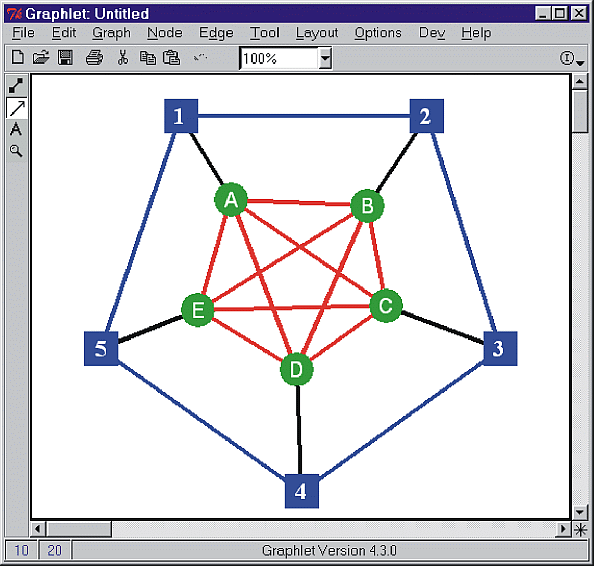Graphlet
Graphlet , by Michael Himsolt, is a toolkit for the implementation of graph editors, and includes drawing algorithms for graphs.
set manifest {
name Graphlet
license GPL
dist {
{
URL http://www.fim.uni-passau.de/fileadmin/files/lehrstuhl/brandenburg/projekte/graphlet/graphlet-5.0.1-lgpl.tar.gz
sha256sum f84c6dde860f2f38ca9f462270ab0bb4b0470af6db1b546a98c4f260d6ad0a53
}
{
URL http://www.fim.uni-passau.de/fileadmin/files/lehrstuhl/brandenburg/projekte/gtl/GTL-1.2.4-lgpl.tar.gz
sha256sum 7325a2aab400d92f92f2883bc58eeba40eb5258aa1067c7d10887307a1f2f053}
}
}Documentation
- The Graphlet System (System Demonstration) , Michael Himsolt
Resources
- The Stony Brook Algorithm Repository
- This is actually for GraphEd, an earlier system by Hichael Himsolt.
Description
Graphscript is a programming language for graphs that is based on Tcl/Tk and LEDA. Graphscript provides all the necessary operations to manipulate and display graphs, and supports the GML file format.
The Graphlet editor is the heart of the Graphlet system, and is implemented in Graphscript. It uses GTL GTL is a C++ library for managing graphs (in the Graph Theory sense). Graphlet is the successor of GraphEd.
Graphlet runs on UNIX and Windows systems, and uses the same source code on all platforms. The key to this level of portability is that all platform dependend features have been deferred to Tcl/Tk. The design of Graphlets makes it easy to port the editor to any other platforms, provided that the LEDA and Tcl/Tk toolkits are available.
The website says "no more available", but the file is actually still available. Graphlet comes with a large set of already available algorithms, including:
- Random Layout
- Spring Embedder with Constraints
- Spring Embedder (GEM)
- Spring Embedder (FR)
- Spring Embedder (KK)
- DAG Layout
- Tree Layout
